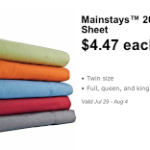
Creating space and guiding conversations about race in the classroom is no easy task. It can be downright scary and the feelings of anxiety that evoke leave many teachers avoiding the topic altogether.
Before I share my experiences I just want to state that in no way am I any sort of expert. I am simply here to share my experiences and what I have learned along the way. I have been lucky enough to have opportunities to take part in equity work that have forever changed who I am as a human being and continue to do so day after day. The urgency I feel to move this work in my classroom and beyond has driven me to write this post. I have typed and trashed this piece more times than I care to remember. Each time I begin creating a draft the anxiety within me creeps up. Working with kids and empowering them to go out and be a positive influence is one thing. Sharing what I’ve learned with adults is a whole other world of scary. However, if there is one thing I have learned for certain about the work of equity; it’s that the work is not about me. So with that I write this post hoping that it gives just one teacher the courage to embrace conversations about race in their classroom.

My kids were standing in line when I overheard a student say “It’s okay. You can Chinese cut me.” A few years ago I am not sure how I would have responded. I’m sure I wouldn’t have addressed the fact they called it a “Chinese” cut. I probably would have said we don’t cut at all and sent the student to the back of the line. Instead, in this moment I took 60 seconds to ask if they knew why it was called a Chinese cut. Neither student knew. Honestly, I wasn’t positive either, but I figured that it was because China was on the other side of the world so to kids that’s the opposite. I explained this to both students and all the others nearby listening in. We quickly talked how calling it a Chinese cut could be hurtful to many people. I assured them that I knew this was not their intent, but that it’s important that we use our words carefully. It was a simple conversation that resulted in one of the students saying “Ya, we should just call it an opposite cut.” Though many might say that using the term Chinese cuts is no big deal, is it really a big deal to put a stop to it, then?
In the elementary classroom there are so many moments like this one where conversations about race come up authentically. Often times it can be our first impulse to respond with “We don’t say that.” Instead, have a conversation about it. You will be amazed with how much these kids understand and how much they can handle. We may not know for sure the impact that these short conversations will have in the long run, but we do know that they’re worth having.

Again, moving the work of equity isn’t about you. It’s not always comfortable and in the moment it can even feel clunky. The more you make space and allow opportunities for students to have conversations involving race the more comfortable it will become.
During a community circle one student shared that her and her mom were in a car accident over the weekend. During her story she mentioned that the person who rear-ended them was Mexican and probably didn’t have insurance.
A knot immediately formed in my stomach. This was a moment where a conversation about race had to happen and I wasn’t even sure where to go with it. Students had been unknowingly flooded, yet again with another countless stereotype. This brings me to my next point in facilitating these conversations.

Instead of saying to the student “You can’t say that.” or “That’s not nice.” or “Oh, I’m glad you’re both okay.” I chose to ask questions and begin a conversation that went where I never could have expected. I asked, “What makes you think they didn’t have insurance?” To that she replied, “My mom said that Mexicans don’t have insurance.” I continued by asking another question, “Do you think all Mexicans don’t have insurance?” and she replied with “No. I think some do.” I gave her another question-ish response with “I wonder why some people don’t have insurance.” From there I opened it up to the rest of the class and what happened was pretty incredible.

One student responded, “I think some people don’t have insurance because they don’t have a lot of money.”
Another student replied, “My aunt doesn’t have insurance anymore because she got her car towed too many times.”
There were several other responses.
A hispanic boy joined the conversation; “When people say that Mexicans don’t have insurance it makes me mad. I am Mexican and my dad has insurance.”
Another boy said, “I think a lot of people don’t have insurance, but that doesn’t mean they’re Mexican.” I continued pushing the conversation to see what they came up with on their own. They didn’t need me to lead them to the conclusion that Mexicans aren’t the only people that drive around uninsured. The class unanimously agreed that it’s not fair to say things about whole groups of people based on their race.
I did make sure to check in with a few students who I thought could have really been impacted by the conversation and needed more from me. It’s important to validate students who need it in those moments, but also recognize that the conversation isn’t done.

Know that when you are creating space for conversations surrounding race in your classroom that you will rarely, if ever come to a place of closure. This is the nature of the work. Expect to continue the conversation. Listen to what your students need and what they’re ready for.
Our conversation that day was about so much more than uninsured Mexican drivers. It was the gateway to a bigger conversation that needed to happen. My students were already building a bank of stereotypes. I knew that I needed to raise their consciousness around stereotyping and empower them to do things differently. I wasn’t ready to do this in the moment and that’s okay. It’s important to sit with that discomfort with the intent of coming back to it and continuing the conversation with renewed purpose.
After allowing myself some time to think through what my kids were ready for and what they might need from me here is how some of that next piece played out.
We talked about what a stereotype is. We didn’t talk about stereotypes that we’ve heard because in third grade there are many stereotypes students haven’t heard and the point is not to expand their experiences with these stereotypes, but to raise their consciousness around them for future encounters.
We talked about what a stereotype is and how it can cause hurt and create false narratives or stories about people.
Then we used this quote to talk about bravery and how bravery can give us the power to make the world better by stopping stereotypes. We brainstormed things we could say to someone when we hear a possible stereotype about a group of people.

Finally, we watched this beautiful and powerful video from the Black Violin group called Stereotypes.
When it comes to the facilitating these conversations in the classroom you won’t always know if you’re doing it “right”. I’m not sure there is anyone out there who does. You will, however know that you are doing something. You are providing your kids the safe space to collaboratively navigate a part of the world they are already living in, but often don’t talk about. You are giving students opportunities to see and do things differently. You are paving the way for these kids to change the world!












Leave a Reply